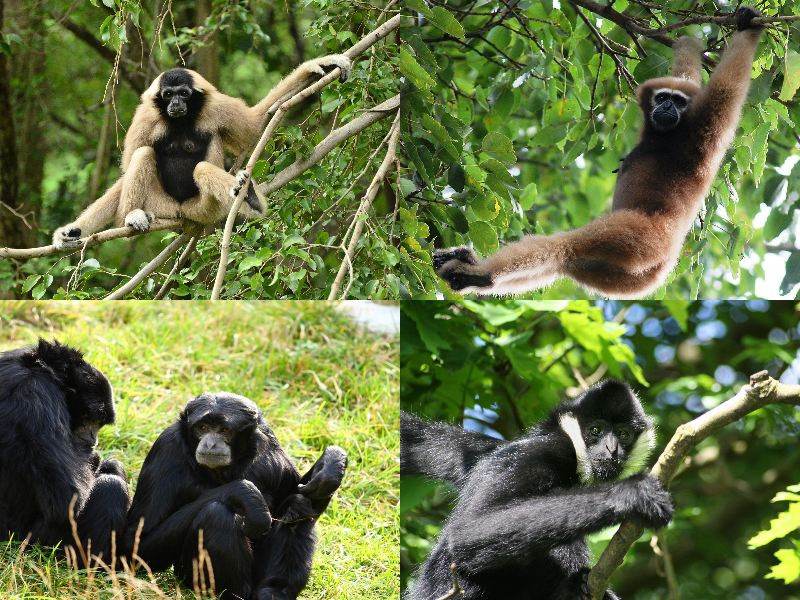Facts for Kids
Gibbons are small, agile apes known for their long arms, complex vocalizations, and arboreal lifestyle in Southeast Asian forests.
Overview
Gibbons In Culture
Research And Study
Conservation Status
Diet And Feeding Habits
Habitat And Distribution
Physical Characteristics
Reproduction And Life Cycle
Behavior And Social Structure

Inside this Article
Critically Endangered
Southeast Asia
Communication
The Jungle
Territory
People
Mother
Golden
Food
Did you know?
🦧 Gibbons are primarily arboreal primates, spending most of their lives in trees.
🌍 They are found in the tropical and subtropical forests of Southeast Asia.
🎤 Gibbons are known for their distinctive singing, often engaging in duets with their partners.
👫 They typically live in monogamous family groups, consisting of a mating pair and their offspring.
🏃♂️ Gibbons are incredibly agile and can swing from branch to branch at speeds of up to 35 miles per hour.
🌳 Their arms are longer than their legs, which aids in their brachiating movement.
🦙 Gibbons have a varied diet that primarily consists of fruits, but they also eat leaves, flowers, and insects.
⏳ They generally have a lifespan of 25-30 years in the wild.
🔊 There are several species of gibbons, including the lar gibbon, siamang, and white-handed gibbon.
💔 Gibbons are endangered due to habitat loss and poaching.
Introduction
There are 20 species of gibbons found in Asia, particularly in countries like Indonesia, Thailand, and China. They are sometimes called "lesser apes" because they are smaller than great apes like gorillas and orangutans. Gibbons are unique for their long arms and agile movements; they can swing through trees at speeds of up to 35 miles per hour! 🐒
Their songs can travel over 2 miles through the jungle, helping them communicate with each other. Isn’t that cool?
Gibbons In Culture
In some Asian countries, gibbons are featured in folklore and traditional stories due to their loud calls and unique behaviors. People admire their agility and use them as inspirations in art and dance. 🕺
Some cultures view gibbons as symbols of keeping families together, echoing their strong social bonds. They often remind us about respecting nature and protecting wildlife. Gibbons are also popular in zoos, where they educate visitors about their behavior and conservation needs, helping children learn about these wonderful animals!
Research And Study
Researchers often spend time in forests observing gibbons in their natural habitats to learn how they interact with each other and their environment. By analyzing their songs and calls, researchers can uncover how gibbons establish territories. This research is crucial for developing effective conservation strategies to protect these incredible primates. With your help, awareness can grow, and more people can support efforts to preserve gibbons and their forest homes! 🌳
Conservation Status
Many gibbon habitats are being cut down for farming and logging, which makes it harder for them to find food. The International Union for Conservation of Nature (IUCN) lists several gibbon species as critically endangered. Organizations worldwide work to conserve their habitats and protect them from poaching. 🌱
Conservation efforts include creating protected forest areas and educating local communities about the importance of gibbons in the ecosystem, ensuring they have a future!
Diet And Feeding Habits
They also enjoy leaves, flowers, and insects. Some of their favorite fruits include bananas, figs, and berries. Gibbons spend a lot of their day searching for food high up in the trees, using their long arms to swing and reach the tastiest treats. They are clever foragers and can tell when fruits are ripe and ready to eat. 🍏
A fun fact is that a gibbon can eat up to 50 kinds of fruits in one feeding day!
Habitat And Distribution
They are found in Southeast Asia, primarily in countries like Indonesia, Malaysia, Vietnam, and Thailand. Some gibbons prefer living in the canopy, which is the top layer of the forest, while others like to stay closer to the ground. Gibbons thrive in these environments because they provide plenty of trees to swing from and fruits to eat. Their range can stretch from the dense jungles of Borneo to the hilly forests of China, showcasing their diverse habitat!
Physical Characteristics
They have a unique appearance with black fur, white fur, or even golden fur, depending on the species. The popular Siamang gibbon has a special throat pouch that helps it make loud calls. Most gibbons have long fingers and toes that assist them in gripping branches tightly. They usually weigh between 10 to 25 pounds, making them light enough to move quickly. A fun fact is that their arms can be up to 1.5 times the length of their bodies! 🦵
Reproduction And Life Cycle
Infants cling to their mother's fur and start learning how to swing themselves by the age of 6 months. They are weaned (stop nursing) around 1 year old and stay with their parents for about 3 to 4 years, learning essential skills for survival. 🐾
Gibbons reach maturity at about 4 to 6 years old, when they can begin to find their own mates and start families. This strong parent-child bond is crucial for raising the next generation.
Behavior And Social Structure
👩👧👦 They spend a lot of time playing and grooming each other, which helps bond the family. Gibbons are also known for their beautiful singing, which is a way to establish territory and communicate with other groups. 🎶
Each species has its own unique song! They are mostly monogamous, meaning they have one mate for life, and they can be very protective of their family members.
Gibbon Quiz
Frequently Asked Questions
Our Mission
To create a safe space for kid creators worldwide!
2025, URSOR LIMITED. All rights reserved. DIY is in no way affiliated with Minecraft™, Mojang, Microsoft, Roblox™ or YouTube. LEGO® is a trademark of the LEGO® Group which does not sponsor, endorse or authorize this website or event. Made with love in San Francisco.

